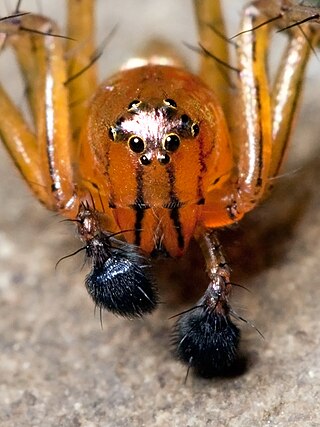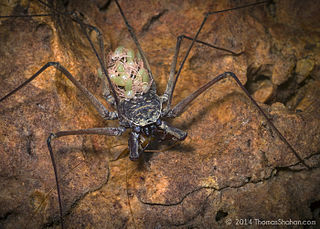
Arachnida is a class of joint-legged arthropods, in the subphylum Chelicerata. Arachnida includes, among others, spiders, scorpions, ticks, mites, pseudoscorpions, harvestmen, camel spiders, whip spiders and vinegaroons.

Amblypygi is an order of arachnids also known as whip spiders or tailless whip scorpions, not to be confused with whip scorpions or vinegaroons that belong to the related order Thelyphonida. The name "amblypygid" means "blunt tail", a reference to a lack of the flagellum that is otherwise seen in whip scorpions. Amblypygids possess no silk glands or venom. They rarely bite if threatened, but can grab fingers with their pedipalps, resulting in thorn-like puncture injuries.

The Opiliones are an order of arachnids colloquially known as harvestmen, harvesters, harvest spiders, or daddy longlegs. As of April 2017, over 6,650 species of harvestmen have been discovered worldwide, although the total number of extant species may exceed 10,000. The order Opiliones includes five suborders: Cyphophthalmi, Eupnoi, Dyspnoi, Laniatores, and Tetrophthalmi, which were named in 2014.

Uropygi is an arachnid order comprising invertebrates commonly known as whip scorpions or vinegaroons. They are often called uropygids. The name "whip scorpion" refers to their resemblance to true scorpions and possession of a whiplike tail, and "vinegaroon" refers to their ability when attacked to discharge an offensive, vinegar-smelling liquid, which contains acetic acid. The order may also be called Thelyphonida. Both names, Uropygi and Thelyphonida, may be used either in a narrow sense for the order of whip scorpions, or in a broad sense which includes the order Schizomida.

Pedipalps are the secondary pair of forward appendages among chelicerates – a group of arthropods including spiders, scorpions, horseshoe crabs, and sea spiders. The pedipalps are lateral to the chelicerae ("jaws") and anterior to the first pair of walking legs.

Plesiosiro is an extinct arachnid genus known exclusively from nine specimens from the Upper Carboniferous of Coseley, Staffordshire, United Kingdom. The genus is monotypic, represented only by the species Plesiosiro madeleyi described by Reginald Innes Pocock in his important 1911 monograph on British Carboniferous arachnids. It is the only known member of the order Haptopoda.

Phalangiotarbida is an extinct arachnid order first recorded from the Early Devonian of Germany and most widespread in the Upper Carboniferous coal measures of Europe and North America. The last species are known from the early Permian Rotliegend of Germany.

Tetrapulmonata is a non-ranked supra-ordinal clade of arachnids. It is composed of the extant orders Uropygi, Schizomida, Amblypygi and Araneae (spiders). It is the only supra-ordinal group of arachnids that is strongly supported in molecular phylogenetic studies. Two extinct orders are also placed in this clade, Haptopoda and Uraraneida. In 2016, a newly described fossil arachnid, Idmonarachne, was also included in the Tetrapulmonata; as of March 2016 it has not been assigned to an order.

Ogoveidae is a family of harvestmen with three described species in one genus, Ogovea, which is found in equatorial West Africa.

The Pettalidae are a family of harvestmen with 75 described species in 10 genera. Several undescribed species are known or assumed in some genera.

Phrynus marginemaculatus, simply known as spotted tailless whip scorpion is a species of amblypygid found in southern Florida, the Bahamas, Cuba, and Hispaniola. They are nocturnal predators that hide during the day in small retreats.

Mastigoproctus giganteus, the giant whip scorpion, also called the giant vinegaroon or grampus, is a species of whip scorpions in the family Thelyphonidae. Its native range is from the Southern United States to Mexico.
Gonzalo Giribet is a Spanish-American invertebrate zoologist and Alexander Agassiz Professor of zoology working on systematics and biogeography at the Museum of Comparative Zoology in Harvard University. He is a past president of the International Society for Invertebrate Morphology, of the Willi Hennig Society, and vice-president of the Sociedad Española de Malacología.

Phrynus is a genus of whip spiders found in tropical and subtropical regions, mostly in the new world.

Phrynidae is a family of amblypygid arachnida arthropods also known as whip spiders and tailless whip scorpions. Phrynidae species are found in tropical and subtropical regions in North and South America. Some species are subterranean; all are nocturnal. At least some species of Phrynidae hold territories that they defend from other individuals.

Neosiro exilis is a species of mite harvestman in the family Sironidae. It is found in North America.
Phrynichus is a genus of tailless whipscorpions in the family Phrynichidae. There are about 16 described species in Phrynichus.

Weygoldtina is an extinct genus of tailless whip scorpion known from Carboniferous period, and the only known member of the family Weygoldtinidae. It is known from two species described from North America and England and originally described in the genus Graeophonus, which is now considered a nomen dubium.
















